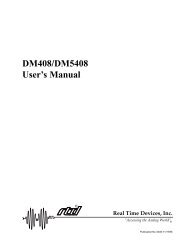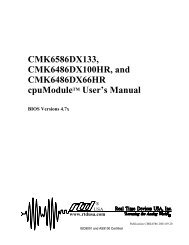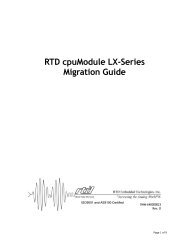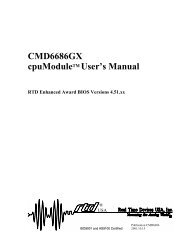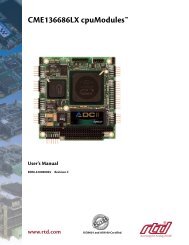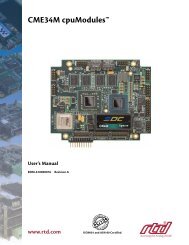Hardware Manual - RTD Embedded Technologies, Inc.
Hardware Manual - RTD Embedded Technologies, Inc.
Hardware Manual - RTD Embedded Technologies, Inc.
You also want an ePaper? Increase the reach of your titles
YUMPU automatically turns print PDFs into web optimized ePapers that Google loves.
Programming the DM6425HR<br />
This section gives you some general information about programming and the DM6425HR.<br />
The DM6425HR is programmed by writing to and reading from the correct I/O port locations on the board.<br />
These I/O ports were defined in the previous section. Because the DM6425HR is AT bus compatible, most<br />
operations are done in a 16-bit word format. The 8254 timer/counters must be programmed in 8-bit operations.<br />
High-level languages such as Pascal, C, and C++ make it very easy to read/write these ports. The table below<br />
shows you how to read from and write to I/O ports in Turbo C and Turbo Pascal.<br />
Language Read 8 Bits Write 8 Bits Read 16 Bits Write 16 Bits<br />
Turbo C Data=inportb(Address) outportb(Address, Data) Data=inport(Address) outport(Address, Data)<br />
Turbo Pascal Data:=Port[Address] Port[Address]:=Data Data:=PortW[Address] PortW[Address]:=Data<br />
In addition to being able to read/write the I/O ports on the DM6425HR, you must be able to perform a variety<br />
of operations that you might not normally use in your programming. The table below shows you some of the<br />
operators discussed in this section, with an example of how each is used with Pascal and C.<br />
Language Modulus Integer Division AND OR<br />
C %<br />
a = b % c<br />
Pascal<br />
MOD<br />
a := b MOD c<br />
/<br />
a = b / c<br />
&<br />
a = b & c<br />
|<br />
a = b | c<br />
DIV<br />
a := b DIV c<br />
AND<br />
a :=b AND c<br />
OR<br />
a :=b OR c<br />
Many compilers have functions that can read/write either 8 or 16 bits from/to an I/O port. For example, Turbo<br />
Pascal uses Port for 8-bit port operations and PortW for 16 bits, Turbo C uses inportb for an 8-bit read of a port<br />
and inport for a 16-bit read.<br />
CAUTION Be sure to use the correct function for 8- and 16-bit operations with the DM6425HR!<br />
Clearing and Setting Bits in a Port<br />
When you clear or set one or more bits in a port, you must be careful that you do not change the status of the<br />
other bits. You can preserve the status of all bits you do not wish to change by proper use of the AND and OR<br />
binary operators. Using AND and OR, single or multiple bits can be easily cleared in one operation.<br />
To clear a single bit in a port, AND the current value of the port with the value b, where b = 255 – 2 bit .<br />
Example: Clear bit 5 in a port. Read in the current value of the port, AND it with 223(223 = 255 – 2 5 ), and<br />
then write the resulting value to the port. In BASIC, this is programmed as:<br />
V = INP(PortAddress)<br />
V = V AND 223<br />
OUT PortAddress, V<br />
To set a single bit in a port, OR the current value of the port with the value b, where b = 2 bit .<br />
Example: Set bit 3 in a port. Read in the current value of the port, OR it with 8 (8 = 23), and then write the<br />
resulting value to the port. In Pascal, this is programmed as:<br />
V := Port[PortAddress];<br />
V := V OR 8;<br />
Port[PortAddress] := V;<br />
58 DM6425HR dataModule BDM-610010034 Rev C



